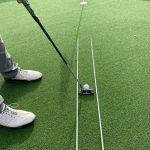Golf is a one-of-a-kind sport. It does not require you to be athletically fit. It does not require you to have years of experience. Neither does it require you to have any supernatural ability. It’s a game for almost everyone, and it’s quite relaxing as well as enjoyable. Don’t worry, in this article, we will discuss how does golf scoring work.
However, beginners in golf often struggle with golf scoring. They find it very complicated and that ruins the fun of it. Are you struggling with golf scoring too?
We will discuss three formats of golf scoring. We will also discuss the term handicap and penalties in golf in the simplest way possible. So, let us begin.
How Does Golf Scoring Works?

Usually, in sports, the player with the most scores wins. But not in golf. In golf, players with the lowest score win the match. Generally, every golf course comes in an 18-hole format.
So, you have 18 matches to play in one go. There, you score for each hole and, in the end, compare with your competitor. Whoever gets the lowest score wins.
The score here is the number of shots/ strokes you need to put the ball in the hole. Wavy holes in the 18 holes have a defined par. The par is the number of shots a professional golf player usually takes for putting the ball in the hole. The more par there is, the distance there is from the hole to the initial starting point of the match. The difficulty level for high par holes is higher.
That is basically a guide to the question “how does golf scoring work?” Let’s talk about the formats of the scoring now.
Different Golf Scoring Formats
There are three scoring formats for golf: StrokePlay, MatchPlay, and Stableford. These three formats of scoring apply when you are playing solo against a partner.
They all have different methods of scoring for shots/ strokes. How does golf scoring work with these three formats? Let us show you.
StrokePlay
StrokePlay is the most common type of scoring format in golf. It is considered the standard. This format uses individual scores to pick a winner of a golf match. You can see its practice widely in all professional golf tournaments. So, in this format, how does golf scoring work?
In the Stroke Play format, you will need to know two things for scoring: The par of each hole, and the stroke that you need to complete that hole. Every attempt of yours will be calculated and recorded in the scorecard.
If your stroke number is equal to the par, then it is a stroke equal par for that hole. In case you have performed more strokes than the par number, then it is a stroke over par. However, if you performed fewer strokes than the par number, then it is a stroke under par. The equal is 0 and the over shots are expressed in a +strokes over par format. For example +2, if you need two strokes more than par. The same goes for under par, but they are expressed in a -strokes less than par. For example, -1 if you needed one stroke less than par.
Based on your stroke number, your score is given some designated names/ golf score terms. Here is a table summarizing the answer to “how does golf scoring work?” in StrokePlay.
Stroke Play
| Stroke | Description | Golf Score Term |
| -4 | Four strokes under par | Condor/ Triple-Eagle |
| -3 | Three strokes under par | Albatross/ Double-Eagle |
| -2 | Two strokes under par | Eagle |
| -1 | One stroke under par | Birdie |
| 0 | Strokes equal to par | Par |
| +1 | One stroke over par | Bogey |
| +2 | Two-stroke over par | Double-Bogey |
| +3 | Three strokes over par | Triple-Bogey |
In the StrokePlay method, the final score is calculated by combining all your strokes and par of all 18 holes in the course. So, the score you see in the table is calculated at the very end of every golf course.
Let’s say you and your friend have finished an 18-hole golf course.
The combined par of the course/ course par is 120. Your combined stroke is 123. According to the table, your stroke is 123-120=3. It is a positive number and you have achieved the term Triple-Bogey.
But say, your friend has performed 119 strokes. Her score is 119-120= -1. So, she scored one stroke under par and achieved Birdie.
Since her score is lower than yours, she has won the match. That is basically how golf scoring works in StrokePlay. Now let us take a look at the MatchPlay format.
MatchPlay
This format is a little different from others. Rather than your stroke number, this format calculates how many holes you have won. To determine which holes you have won, we turn to the StrokePlay format again.
You can say that, in this format of the scoring, we determine the winner of each hole after they are completed.
So, for this method, we will need to know the par and stroke of each hole. The one with the least stroke wins that hole. At the end of the course, we sum up the number of holes won by each player. The one with the highest number of wins is the winner of that golf match.
This method is ideal for beginners since there is less technicality involved.
The MatchPlay method is sometimes referred to as “holes up and holes down” Rather than saying holes won and lost, they say he’s up and holes down.
Stableford
Stableford is also a point-based scoring format, like the StrokePlay method. But unlike StrokePlay, players with more points win the match. Let us explain.
In this format, players are awarded points after each hole. The point table is set up by the par and handicap for the holes.
There is also a twist in the rules. If any player fails to complete the hole within two strokes above, then he/ she is not allowed to complete that hole. Their score is 0 for two strokes over par.
The points start from 0. Usually, for two strokes above par, the point is 0. But that can change depending on the handicap of players.
Here is a standard score table for the Stableford golf scoring model.
Stableford Golf Scoring Model
| Points | Stroke | Description |
| 0 | +2 | Two-stroke over par |
| 1 | +1 | One stroke over par |
| 2 | 0 | Strokes equal to par |
| 3 | -1 | One stroke under par |
| 4 | -2 | Two strokes under par |
| 5 | -3 | Three strokes under par |
| 6 | -4 | Four strokes under par |
At the end of all 18 holes, the points are summed up. Players with the highest points win the golf match.
So, this is how golf scoring works. Players follow either of these three formats. Both players have to agree on a specified format and it has to be determined at the beginning.
However, some important things can also play a role in how golf scoring works, such as penalty and handicap.
Some Important Aspects of Golf Scoring
Here are some important facts about golf scoring. In this section, we will discuss how golf players keep track of their scores, how penalty affects their scores, and what a handicap is in golf. So, let’s begin!
Keeping Track of Scores
We have discussed how golf scoring works. But did we mention who keeps track of the scores? In professional golf tournaments, there are referees. But there will be no referee when you are playing with your friends.
Unless you and your partner have hired a third person for scorekeeping, you two have to do it together.
For keeping track of scores, you will be provided with a scorecard. But rather than writing down your score on it, you write down your opponent’s score. Your opponent is also responsible for writing down your score.
After each round/ hole, both of you note down the scores. Then, both of you check on each other’s scores and verify the information by signing on the document. Now, if there is any mistake done in noting down the score, you two are free to clarify that among yourselves. Moreover, you must record your scores after every hole. Otherwise, you may forget and the result will get flawed.
So, that is how tracking scores is done in golf.
Handicap
A handicap applies to a golf player when he/ she has played at least 10 times in the same golf course. It differs for each player. Let’s explain it even further.
Suppose you have played all 18 holes in a golf course over 10 times. In hole number 3, your average stroke is 4. That is considered your handicap. The goal of this handicap is to ensure that you do better than that. So, on the number 3, your current target should be less than stroke 3. It does not matter if the par of that hole is 4.
A handicap can be considered a personal challenge to yourself in golf.
If you are playing in Handicap, then try playing in the Stableford format. This will make things more complicated and challenging for you. Because in the Stableford format of scoring, you are not allowed to hit a ball after two strokes above par.
For beginners, handicap does not apply. It only applies if you have played in the same golf course at least 10 times.
Penalties
One of the most important aspects of any sport is penalties. Golf is not an exception. Golf has many penalties. The penalties have changed over the years and went through many revisions.
Penalties will increase your points. Is it a bad thing? Yes. Do you remember what we mentioned about how golf scoring works? The player with the lowest score wins. Penalties will increase your score and so you will likely lose.
There are penalties for dropping the golf ball on the water, losing the ball, hitting out of bounds, and even touching the sands. Let’s discuss them below.
Dropping The Golf Ball n Water
On a golf course, there are different types of terrains. There are snd pools and lakes. Commonly, your ball will land on them. Or they may land on a slope and roll down to them.
If your ball falls in the water, then it is a penalty. If the ball has gone into the water, you will have to take a one-stroke penalty.
You will have to start by using a new ball in the designated location of the course.
Hitting The Golf Ball Out Of Bounds
The bounds of the golf course are indicated by white stakes. If your golf ball lands outside of these bounds, then there is a penalty.
The penalty of hitting the golf ball outside of bounds is two strokes. If that happens, you are required to hit the ball again from the original location.
Losing The Golf Ball
If by any means, aside from dropping the ball on the water, you lose your golf ball, then you will have to face a penalty. The penalty is a two-stroke penalty and you will have to hit the ball from the original spot.
Touching The Sands
There are many sand pools on the golf course. They are often referred to as bunkers. There are some scenarios where a player is not allowed to touch the sand in the bunker.
One of the most common scenarios is touching the bunker during a practice shot. Why? Because the purpose of the sand bunker is to make the stroke more difficult than a normal stroke. So, players are not allowed to touch the sand for practice shots. And the penalty of illegally touching the sand is one stroke.
However, some scenarios allow you to touch the sand in the bunker. If there is an object, such as tree limbs in the bunker, then you are allowed to touch and move it. But, accidental touching of the sand with your club while reading the shot is not considered a penalty.
Conclusion: How Does Golf Scoring Work
So, these are penalties of golf and a guide to understanding “how does golf scoring work?” Hope we were able to help you understand golf scoring and its basics. We wish you good luck in your golf match.






